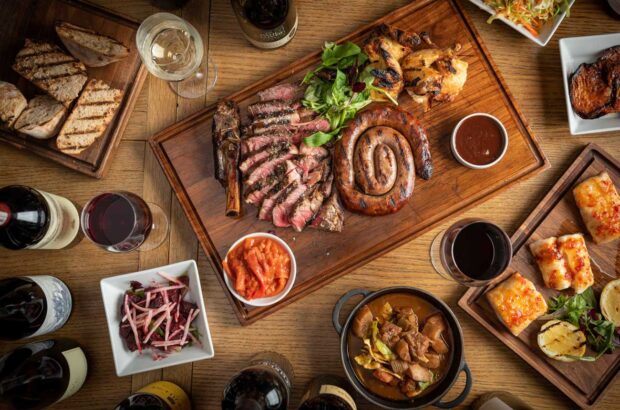As they move towards a more forward fruit style, the wines of Bordeaux are drinking younger. But will these wines age well? John Stimpfig reports.
Ask Pierre Lawton whether today’s great clarets are more approachable and less age-worthy than the historic vintages of the past and you’ll get short shrift from the young négociant. ‘It’s a myth,’ he says. To illustrate his point, he recounts the story of his grandfather washing down classed-growth cask samples of the famous 1929 vintage with an entrecôte. At the time, grand-père Lawton thought the wines were almost too good to be true. ‘But look at them now,’ says his grandson. ‘They have aged beautifully.’ Having recently tasted some of the 2000s, which were still in barrel, I can almost sympathise with this sort of indecent infanticide. But one great vintage doesn’t prove Lawton’s rule. So let’s put the question another way. How different are today’s more forward Bordeaux wines to the likes of a Mouton 1945 or a Cheval Blanc 1947? Jean-Marie Chadronnier of the CVBG is in no doubt about the similarities. ‘The great vintages of the 1940s were not that different in style from the great vintages of more recent times, simply because they were very ripe years,’ he points out in Stephen Brook’s excellent recent book, Bordeaux: People, Power and Politics.
https://www.decanter.com/learn/wine-legend-chateau-mouton-rothschild-1945-374280/
In fact, if you ask almost anyone in Bordeaux, you’ll get the same standard response. Namely, that the very top wines of the last decade or two, including the 2000s, will easily collect their pensions, just like their superstar predecessors. ‘Today, people think that because a wine has riper tannin with less acid, its ageing potential is reduced,’ says Château Haut-Brion’s ultra-traditional general manager, Jean-Bernard Delmas. ‘But we know that the great vintages of the past were always picked ripe and early in September. And, like today’s wines, they were made with low acidity. So if you look at how wines such as the 1955, 1959 and 1961 are performing, you’ll find that not only are they showing well now, they will certainly keep for some years yet.’ Famous oenologist Michel Rolland also points out that all the historic vintages of the past were short cycle years. In other words, they were early budding and early harvests, which yielded ripe, low-acid grapes in perfect condition. ‘So my conclusion is very simple and not very technical – the shorter the cycle, the better the wine,’ he says. ‘If we repeat these conditions, I don’t see why the new wines won’t age.’
So why is there this perception that the style and quality of Bordeaux wines have changed over the last 50 years? ‘Because they have,’ says Pierre Lawton. ‘But the difference lies not in the great vintages, which have never required much in the way of intervention because they were almost boringly easy to make. Instead, the real revolution lies in the less good vintages.’ This is a view that resonates with many in Bordeaux, including Hervé Berland, director of château wines at Mouton-Rothschild. ‘It’s all very well comparing today’s wines with benchmarks like the Mouton 1945, but in so doing we forget to speak about the less good vintages, such as the 1967, 1968, 1969 and 1974, which didn’t age so well. This is where Bordeaux has improved in leaps and bounds over recent decades, because we have so much more knowledge and capability now.’ Naturally, there are many reasons why Bordeaux is making better wines, including desire, talent and investment, but the process necessarily begins in the vineyard where a host of innovations have conspired to raise the quality bar. These range from soil analysis to more diverse clonal material, better pruning, correct plant densities, lower yields, appropriate rootstocks and so on. Then come techniques such as green harvesting and leaf plucking to improve bunch ripeness, airflow and sunlight exposure. And as a back-up, there are fungicides and anti-rot sprays if required. Without this level of modern-day effort, technology and investment, ripe grapes in imperfect vintages are almost impossible. However, perhaps the most dramatic and far-reaching viticultural change affecting the style and taste of Bordeaux has been how and when grapes are picked. ‘In the past, the great fear was rain at harvest time, and often we picked too early, as in 1974, 1978 or 1979, in order to avoid it,’ says Berland. ‘Not only that, picking would start at one end of the vineyard and finish at the other. Now we pick parcel by parcel, when we have tasted and analysed the grapes for sugar, tannin and phenolic ripeness.’ He continues, ‘Also, today, we are not so afraid of picking later and taking a risk. Last year, for instance, it was a ‘stop-go’ harvest. We started to pick for two days and then stopped for two days because of bad weather. The time from start to finish was three weeks. It means we get much riper tannin and fruit and lower acidity.’ What is also interesting is that weather patterns also seem to be assisting Bordeaux’s evident willingness to harvest riper grapes. ‘In the last 10 years, we know that the average temperature is higher than it used to be,’ says Jean-Bernard Delmas. ‘More importantly, the average summer temperature is one degree higher than in the past. That is a lot and it helps to create the favourable, faster growing season, with vines starting and finishing their growing cycle sooner. Of course, that helps to bring forward the picking date, which is very beneficial.’
In the bad old days, fear of autumnal rains swelling and diluting the juice and causing rot wasn’t the only reason for picking early. Before temperature control was introduced during the 1960s and 1970s, no one knew how to handle the fermentation process for musts with a high potential alcohol. One obvious danger when the temperature rose too much was a stuck fermentation, because the yeasts couldn’t function. The solution was simple – pick early at a lower potential alcohol. ‘In those days, every cellarmaster knew that 11% potential alcohol would present no problem, so that was what determined the picking date,’ says Delmas. ‘Inevitably, the wines were more acid and the tannins were not as completely ripe as they are today. They were also rough and coarse when young, so you had to keep the wine in cask and bottle a long time before you had something drinkable. Now, because we can control the fermentation temperature, we can pick later and riper so that the tannins are softer and smoother and the wine is less acid. What this means for the consumer is that a great wine like Haut-Brion is much more pleasant to drink when young. We have opened the drinking window earlier, while keeping it open for just as long as before.’ Another factor has been much more rigorous selection for the grand vin. These days, most châteaux can afford this expensive but necessary quality-control measure and there’s no doubt that the introduction of second labels has dramatically improved first wines. Of course, temperature control hasn’t been the only technological advance in the chai to enable better wine in less good vintages. Over the last 40 years, since Professor Peynaud’s ground-breaking work, there have been numerous advances in research, knowledge and practice. Consequently, better hygiene, improved phenolic extraction and better use of new wood are all established. (So, too, is the practice of must concentration, although this will have no effect on the ageing potential of a wine.)
In addition, there have also been more avant-garde developments by the likes of Right Bank garagistes and well-known micro-cru estates, some of which remain extremely controversial, while others are merely marginal. These include techniques such as malolactic en barrique, cold pre-fermentation soaks and micro-oxygenation, which gently bubbles tiny amounts of oxygen into a cask. Supporters such as Dr Alain Raynaud, who has château interests on both banks, claim that such methods as micro-oxygenation are more gentle than racking the wine, and also softens the tannins and fixes colour. However, opponents such as John Kolasa at Château Canon aren’t so sure of the long-term benefits, believing that if you use too much oxygen, the wine will age too quickly. Then there’s the whole debate over whether some in Bordeaux are picking overripe grapes and making over-extracted wines. Delmas, for one, is against it. ‘It’s a question of degree. If you have too much tannin and low acidity, you may not notice the “aggressivity” at first. However, as it ages, the wine slowly dries out.’ As ever, time will tell.
Yet in spite of these ongoing arguments, over the last 40 years Bordeaux wines have qualitatively and stylistically changed for the better, largely thanks to an array of technological and viticultural improvements. The net result of all this is that more châteaux are capable of making great wines than ever before, while fewer are making bad Bordeaux wines, even in poor vintages. Ironically, though, the biggest change has not been in the fabulous vintages, which will continue to show beautifully from cradle to grave. Instead, the real revolution has meant that the dilute, green, unripe or over-tannic vintages of the 1950s, 1960s and 1970s have been banished forever – and that is an achievement worth drinking to.







